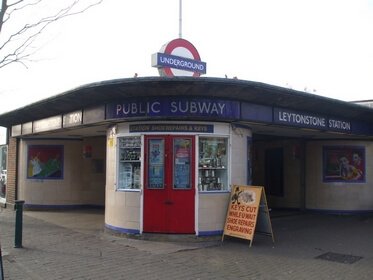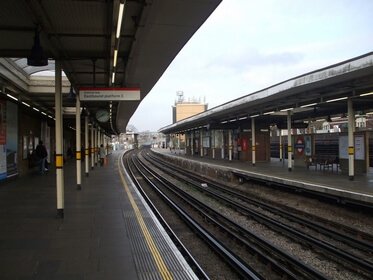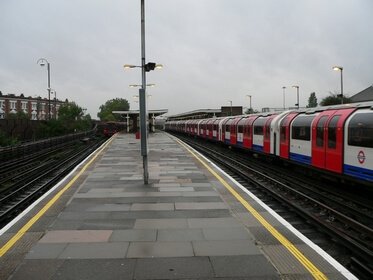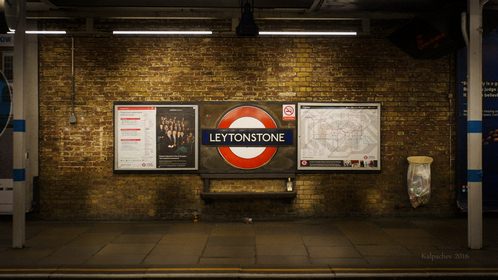Alfred Hitchcock
Leytonstone Tube Station
Station
Leytonstone Tube Station
Church Lane
Leytonstone
London E11 1HE
A mere walking distance from where Alfred Hitchcock was born, there was and still is Leytonstone tube station, which accommodates local population with need to travel in an ever-growing active and vibrant city of London. It is located on Church Lane - High Road's side-street, and is on the edge of Zones 3 and 4 of the metro grid. It is part a central line (a line built in 1933 by then freshly-merged London Transport that goes through the strict city center).
Eastern Counties Railway opened it on 22 August 1856 and while for a long time it is already part of London Underground, it predates it. A year before Leytonstone station was opened, first underground transportation tunnels just started a testing phase near London, while many non-underground stations like the one in Leytonstone were laid out throughout the city (oldest London railway station was up and running in 1836 already).
Few decades later, a fragmented market became more unified as companies decided to start merging their businesses and another few decades later, the name London Underground came to the surface (no pun intended). Leytonstone station was of course part of it.




At the turn of 1939/1940, reconstruction of the whole station took place, during which level crossing was put to bed in favor of an underbridge. In his book Underground, Overground: A Passenger's History of the Tube, Andrew Martin has this to say about that effort: Overall, the eastern end of the Central is a jumble of Victorian and 1940's stylings. At Leytonstone the station was reconstructed to accommodate the arrival of the Central. Bending over backwards to find features of note in London Underground stations, David Leboff comes up with "curved, glazed skylights located in the canopy soffits".
Overall, the eastern end of the Central is a jumble of Victorian and 1940's stylings. At Leytonstone the station was reconstructed to accommodate the arrival of the Central. Bending over backwards to find features of note in London Underground stations, David Leboff comes up with "curved, glazed skylights located in the canopy soffits".Andrew Martin
Unfortunately, that effort had to stop some time after World War II started. The very idea of starting major reconstructions in such a fragile time is probably a testament to how many Brits saw it, or at least wanted to see it: as a conflict that would hopefully soon end in Central Europe. A year or two after the war broke out, Church Street was hit with a bomb by the station's entrance, another two were dropped on close by rails.
The work hasn't been put to waste entirely despite the damage, as station tunnels were useful during the war. Those between Leytonstone and Gants Hill, freshly built to serve the Central line of the Underground, were strategically used as an aircraft component factory. There is no point in getting so off-topic here, but if you're curious, here is a wonderful article about it.
When the war ended, the factory was dismantled and constructions resumed. In 1946, the line was functional up to Stratford, and in 1947 to Leytonstone.
Note that there is also an overground station on High Road by the Trinity Close, about 10-15 minutes by-foot distance south of the tube station.
Stabbing incident
Since the war, there hasn't been much fuzz about the station until beautiful mosaics were installed on its walls as a tribute to Alfred Hitchcock. Except for the occasional visit by tourists interested in them, people quickly grew accustomed to that installation. There was one event that caused the station's name to being dropped in media headlines more than ever before though. It was the news that shook the whole world and you have probably heard about it too.
On 5 December 2015, a Leytonstone local resident attacked 3 men in the tunnels of Leytonstone tube station. The act was unprovoked and had a potential terrorist connotation, as the culprit screamed This is for Syria, my Muslim brothers!
and all your blood will be spilled!
.
What further encouraged press to brand it as a terrorist attack was the unfortunate context - just 2 days earlier Britain started to bomb Islamic State locations in Syria shortly after the decision to do so was approved by the Parliament. And to add to that, less than a month earlier, a series of terrorist attacks took place in Paris and 130 people died as a result. A month later, still in the middle of illegal immigration slash refugee crisis, terrorism was a very hot topic in British media.
The perpetrator was equipped with a 7.5cm-long knife and attacked 3 people, one after another. A 56-year old man got the worst of it, first being punched, kicked and then brought down to the ground where he was beaten further. Then, the aggressor held the victim's head with one hand and began trying to cut it off. The result - a 12cm-long neck wound. Because of that, the sufferer had to be quickly transported to the hospital and operated for 5 hours. Luckily, the operation was a success and his condition was quickly announced to be stable.
The last one of those 3 men was a true hero David Pethers who, after seeing the older man lying down in a pool of blood, rushed to join another man and try to stop the attacker. According to his testimony, he tried it twice, but was unsuccessful on both occasions and suffered a smaller neck wound that wasn't life-threatening.
Part of the crowd was helpful to a limited extent as they made a circle around the bleeding victim to cut off the attacker's direct access to him and some of them tried to tend his wounds.
It took police 4 minutes to reach the scene, it was shortly after Pethers' confrontation. Two officers that got there first immediately engaged the attacker without being overly-aggressive. Moments later, one of them used a taser gun, but that wasn't enough so the other one did the same and then they took him down to the ground and handcuffed him.
The man responsible was identified as Muhaydin Mire (29). He moved to Leytonstone as a teenager, previously worked as an Uber taxi driver and had a history of mental illness. His brother spoke of him having paranoia and mumbling without sense and that he came out of it, but in August 2015 his mental condition again deteriorated. Three weeks before the knife attack, his family contacted police, asking for assistance with his troubles. They were advised to call health services instead.
The man was a practicing Muslim and, coupled with his shouts, it was an expected response to sniff a terrorist attack. As more and more details of the crime emerged, his mental condition became a prime suspect of what pushed him to his actions though. Despite himself claiming his crime was ideological, no connection between him and any terrorist network was discovered.
After the near-tragedy, David Pethers had strong complaints about how bystanders behaved during the incident, he complained that they didn't do enough to stop the attacker. Best video on the scene started circulating the internet quickly and with it a #YouAintNoMuslimBruv hashtag - the man who was filming it said it at some point. Claiming moral high ground while prioritizing filming the event from safe distance instead of trying to help is bizarre to say the least, but that didn't stop him from becoming a hero of the internet for a week or two and hashtag becoming very popular during that period.
